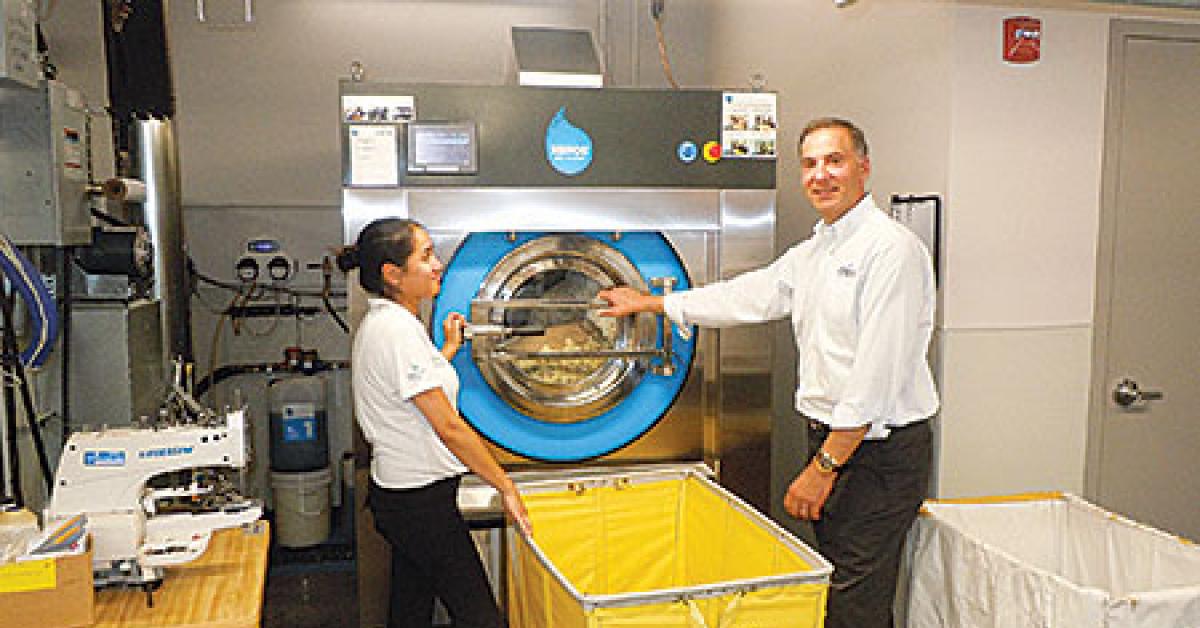GERMANTOWN, Md. — A brand-new technology designed to drastically reduce the use of water and energy is being introduced for commercial, institutional and industrial laundry operations.
The new laundering system, manufactured by Xeros Inc., has recently been installed in several sites in the United States, including at Crest Advanced Dry Cleaners, a retail drycleaning and laundry operation with 10 plants in Virginia and four in Maryland.
The Xeros system uses a proprietary polymer bead technology to achieve mechanical action, and the manufacturer claims it has already reduced water consumption by 80% and virtually eliminated the use of energy in the wash process in these first U.S. installations.
The new technology is generating savings at three plants for Crest. Last month, a representative of American Laundry News toured the company’s new plant and laundering system here in Germantown, some 30 miles north of Washington, D.C.
The Xeros laundry system has also been installed in Choice Hotels and in the Hyatt Regency in Reston, Va.
“Water and energy costs are three times higher in Maryland than they are in Virginia, so it was really a no-brainer for us to install the Xeros technology at our high-volume plants,” says David Slan, president and CEO of Crest Advanced Dry Cleaners. “Our new plant really revolves around the efficiencies of the new laundry system.”
HOW IT WORKS
The system can process table linen, uniforms, clothing and other goods with municipal water at ambient temperatures of 60-70 F. Approximately 1.3 million polymer beads are introduced into a wash cycle—typically for less than an hour—along with the company’s proprietary detergent, “Pack 1.” The beads work to release and absorb soil from the goods.
When a wash cycle is finished, the beads exit through perforations in the drum of the washer and are stored in a bead sump. They can be reused up to 500 times in wash cycles, according to Jonathan Benjamin, president of Xeros Inc. It is unusual to find more than one or two stray beads in the pockets of shirts at the end of a wash cycle, according to the company.
The new laundering system also reduces labor costs because goods do not have to be bagged before they are thrown in the washer, says Jack Culotta, vice president of Crest Advanced Dry Cleaners. “This type of change in technology is revolutionary, not evolutionary,” he adds. “It just blows the traditional wash process right out of the water.”
The scrubbing action and polarizing properties of the polymer beads enable the plant to replace the method used for traditional laundering, according to Culotta. The beads in the Xeros system attract soils, which can be easily discharged.
Most clean items go directly from the Xeros laundry system to finishing. Shirts and other pressed items need to have some moisture in them to be pressed effectively. Heavier items, such as comforters, are dried traditionally.
“Old laundries have been doing laundry the same old way forever,” says Culotta. “What about doing something to improve the environment? What about processing goods more efficiently and profitably for your operation?”
INCORPORATING NEW TECHNOLOGY
Crest wants to be on “the bleeding edge of technology” in the race to remain ahead of its competitors, says Slan. However, the company prefers to take “educated, calculated risks.” Its first Xeros system has been operating for a year at another company plant and yielding superior quality results, according to Slan.
“We tested the Xeros system in our first store for a long time before we embraced it,” he explains. Xeros partnered closely with Crest to generate monthly reports demonstrating savings and efficiencies. “It’s been a marriage of companies,” Slan says. “From the installation to the operation to the maintenance of this system, what has made this relationship wonderful is that there is so much synergy between our companies. We really felt as if they were oriented toward customer support.”
Crest is “extremely happy” with the results and quality of goods washed in the Xeros laundry system, including table linen, uniforms and shirts, Culotta says.
The plant now processes slightly upwards of 50% of its goods and pieces through the Xeros laundering system, which has a 60-pound capacity. As the system continues to demonstrate superior results, that percentage will increase, says Slan, who describes it as “a main staple” of the operation.
“As we build new stores, the most significant change is that we will build them around the Xeros system,” says Slan.
“It will be the first piece of equipment in the plant. It will be an integral part of our operations.”
Improved laundering efficiency represents a major component of Crest’s drive to become good stewards of their corner of the environment, the company says. Crest also insulates all of its steam pipes with PVC, not only to prevent injuries to employees but to reduce the temperatures in its plant and to reclaim steam, so it can be used to heat water.
“Everything we’ve done here in our new plant is designed to use as little energy as possible and to reclaim as much energy as possible,” Culotta explains.
Check back Thursday for conclusion!
Have a question or comment? E-mail our editor Matt Poe at [email protected].
